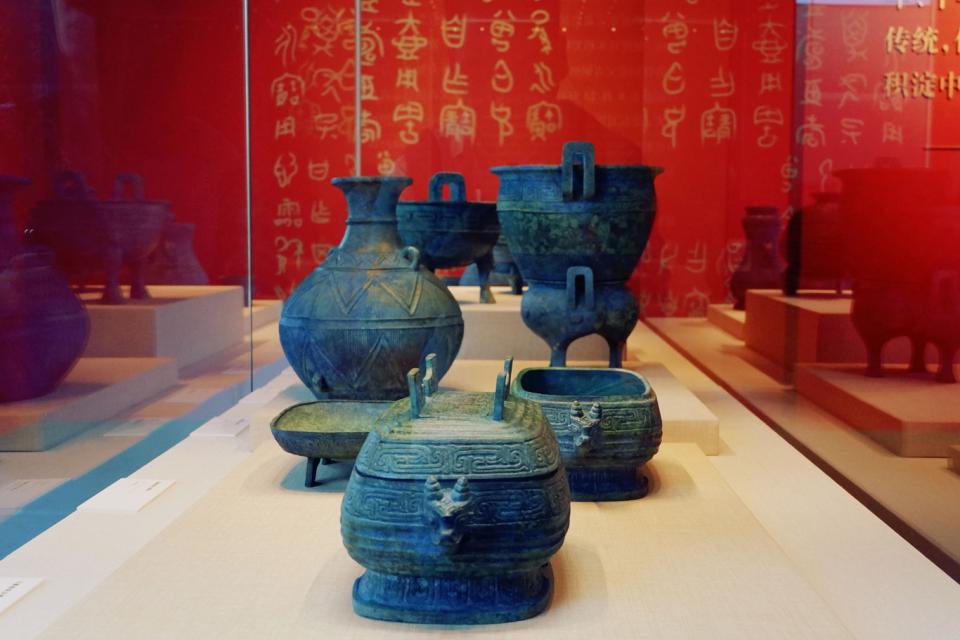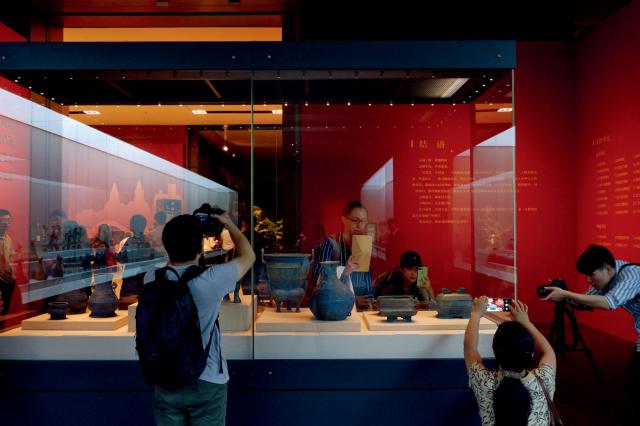As China celebrates the 70th anniversary of the founding of the People’s Republic of China (PRC), a special exhibition dedicated to repatriated cultural relics opened in mid-September at the National Museum of China in Beijing. Continuing through November, the exhibition showcases some 600 artifacts, ranging in date from the Qing Dynasty (1644-1911) to as far back as the Bronze Age Shang Dynasty (16th century-11th century BC), which ruled in the lower Yellow River area. The most recent repatriated relics are eight bronze objects from the Western Zhou Dynasty (1046-771BC), which succeeded the Shang.
The eight bronze objects named “Zeng Bokefu” ware were returned from Japan in August. They are engraved with inscriptions from young people of the day in worship of their ancient ancestors and asking for their blessings.
According to Guan Qiang, deputy director of China’s State Administration of Cultural Heritage (SACH), the Zeng artifacts are the most valuable relics to have been prevented from being sold illegally and returned to China in recent years. “The return of these objects sets an example and reference point for future work on international retrieval of lost cultural relics,” Guan said during an interview with the Xinhua News Agency in early September.
At the end of February, Japanese auctioneer Tokyo Chuo Auction announced in its spring catalogue that the Zhou bronzes were to be auctioned in March. In the introductory remarks, the bronzes were described as having inscriptions made up of 330 characters between them, which indicates their significance to academic research on Chinese calligraphy and bronze artifacts. The total estimated auction price for the objects was initially set at 4.8 to 7.2 million yuan (US$0.67 to 1m). But the real value, according to domestic experts, was perhaps in the tens of million of yuan or more.
According to Zhang Changping, a professor of history at Wuhan University, Hubei Province, the greatest significance of the Zeng bronzes lies in their academic value. “There are no historical records on the Zeng Kingdom, but some preliminary studies on archeological excavations indicate that it had a very important role in China’s ancient history,” Zhang told NewsChina. The bronzes will help give a much better understanding of the Zeng Kingdom, he said.
Once the auction catalogue was put online, Zhang and a few other Chinese experts in relics noticed that the verdigris color (blue-green) of the bronzes, due to oxidation, resembled some already excavated bronzeware from other locations in Hubei Province. It was suspected that the objects might have been smuggled out of China.
Then Tokyo Chuo Auction provided evidence to show these objects were originally owned by an individual. The evidence was a letter written in calligraphy between Xiao Zhenying to a friend called Ke Zinong. According to the letter, Xiao Zhenying, a politician in the period of the Republic of China (1912-1949), sent his personal collection of the eight bronzes to Ke Zinong to safeguard them amid the Chinese Civil War.
A Chinese expert compared Xiao’s calligraphy from historical records with the letter allegedly written by him and found handwriting style inconsistencies in some particular characters. Furthermore, the paper of the letter was found not to date from that period. “We proved the letter was faked, and through investigations, we finally found the bronzes were not a collection from the period of the Republic of China, but from excavations in the last two decades from tombs belonging to nobility during the Zeng Kingdom era in Hubei Province,” Guan Qiang told
NewsChina.
On March 6, through further investigations, SACH ascertained that none of the 21 supervision and accreditation managing departments for import and export of cultural relics in China had ever approved the export of the eight bronzes. They were proved to have been illegally exported to Japan sometime after 2014.
Although there was no direct evidence of illegal excavation and smuggling of these
artifacts at the time, there was evidence of illegal export, so SACH decided to start immediate procedures to repatriate the relics.
On March 7, SACH and the Ministry of Public Security decided to try retrieving the artifacts through diplomatic channels, along with starting criminal investigation procedures. The next day, Shanghai police found evidence that pointed to the person who had put the items up for auction in Japan, a Chinese man surnamed Zhou.
At the same time, SACH notified the Japanese Embassy to China of the suspected smuggling case and provided its evidence. SACH also requested their Japanese counterparts cooperate with China on the retrieval of these artifacts. On March 9, the auction house announced it was calling off the auction.
NewsChina found from open resources that there had been other similar cancelations of auctions. In October 2016, Yokohama International Auction planned to auction some illegally exported Chinese artifacts and was informed by SACH to stop the auction.
The items were apparently Tang Dynasty frescoes and manuscripts from the Dunhuang Grottoes in Gansu Province, an important repository of ancient Buddhist knowledge on the Silk Road, the South China Morning Post reported.
“The precondition for SACH to be able to call off the planned sale is sufficient evidence to prove the Zeng bronzes were recently excavated and illegally exported artifacts,” Zhang said. A UNESCO Convention on the Means of Prohibiting and Preventing the Illicit Import, Export and Transfer of Ownership of Cultural Property approved in 1970 is currently the legal guideline for returning relics to the rightful owners. It defines “the import, export or transfer of ownership of cultural property effected contrary to the provisions adopted under this Convention by the States Parties thereto, shall be illicit” and requires party states to “take appropriate steps to recover and return any such cultural property imported” back to the states of origin.
In reality, rather than a binding law, the convention is more of an international commitment since the process requires different countries’ mutual understanding, and their effective implementation of the international law. “It does not necessarily mean illegally exported artifacts can be recovered and returned easily,” Zhang said.
It took more than a decade to retrieve artifacts seized in Italy in 2007. After a long judicial process, 796 illegally exported artifacts were finally transported from Italy on March 23. According to Professor Quentin Parker of Hong Kong University, there is a growing trend of countries repatriating artifacts. During an interview with CNN in March, Parker said that China had been very active in pushing for the repatriation of objects that have been shown to have been looted from Chinese tombs. He said that China’s political strength gives it greater leverage when it requests the return of lost relics.
This time, although the process of getting the Zeng bronzes from Japan only took six months, much shorter than the drawn-out process from Italy, there were still a lot of twists and turns, Zhang said.
NewsChina learned from SACH that after the auction was halted, staff from the Chinese Embassy to Japan and the Japanese Foreign Ministry met senior staff from Tokyo Chuo Auction to persuade them to hold on to the artifacts rather than returning them to the client. At the same time, Shanghai police started collecting evidence and tried to convince the illegal owner of the relics to hand them over to Chinese authorities. The owner finally gave in under the pressure and agreed to return the artifacts to China as national property.
SACH did not give NewsChina any more details on the mediation process, nor on the illegal owner. Zhang said that at the end of August, he and another bronzeware expert went to Japan to complete the final evaluation of the artifacts. “When we arrived in Japan, the bronzes were still at the auctioneers,” Zhang said. On August 20, the auction house sent the eight pieces to the Chinese Embassy in Japan for final evaluation and a handover ceremony.
On the night of August 23, the artifacts arrived in Beijing. “Everyone who had a role in the process was so excited when the plane arrived. Until that moment we weren’t sure about the safety of the treasures.”
SACH organized a team of experts to re-evaluate the relics. “The Zeng bronzes are an unprecedented discovery, and they are highly valuable to the research on history and culture during the ancient Spring and Autumn Period (770-476 BC), to the clan and lineage system of the Zeng Kingdom, and to traditional bronze foundry techniques.”
Zhang believes the successful repatriation of the artifacts required strong evidence and legal support, while at the same time it is a testimonial for China’s enhanced national strength and political influence in the world. “This is a wake-up call to anyone who wants to smuggle artifacts. In addition, if there are similar cases in Japan in the future, we can ask for the retrieval based on the precedent of this case,” he said.
China has started to make great efforts to find and repatriate lost cultural relics. According to SACH, more than 150,000 Chinese relics have been returned in 300 separate cases since 1949. It claims that at least 10 million Chinese artifacts have been looted or illegally smuggled to Europe, US, Japan and Southeast Asian countries since 1840. SACH released an online platform in 2017 cataloguing lost Chinese artifacts.
Guan Qiang said that right now, SACH is working on detailed reviews and classification of lost relics and has decided to treat each discovery on a case-by-case basis, according to the background and reason why the items were lost.
In an interview with China Daily in September, Guan explained that cross-border judicial and law-enforcement cooperation have played key roles in the repatriation efforts. He listed a few successful legal cases in this regard which include the return by British police of more than 3,000 smuggled Chinese cultural relics and one of a pair of stone statues stolen from a Tang Dynasty general’s tomb in Hebei Province returned to China following a verdict by a New York court in 2001. The US collector then donated the other one to China.
Some collectors have made personal donations, which have made a great contribution to the return of relics. Guan said that a Buddha image from the Longmen Grottoes in Luoyang, Henan Province that was on display at the National Gallery of Canada was donated back to China in 2001. He added that British authorities approved the return of a bronze bell in 2005 which was taken from a military fortress in Tianjin in 1900 and displayed in a park in Portsmouth for over a century.
According to Zhang Changping, effective measures taken to prevent artifact loss at the source are vitally urgent rather than going through the laborious and expensive process of trying to track and retrieve them later.
“The cost of preserving sites securely is much lower. We should learn our lessons from history and work hard on better preserving our artifacts to prevent future theft and loss.”

 Old Version
Old Version
